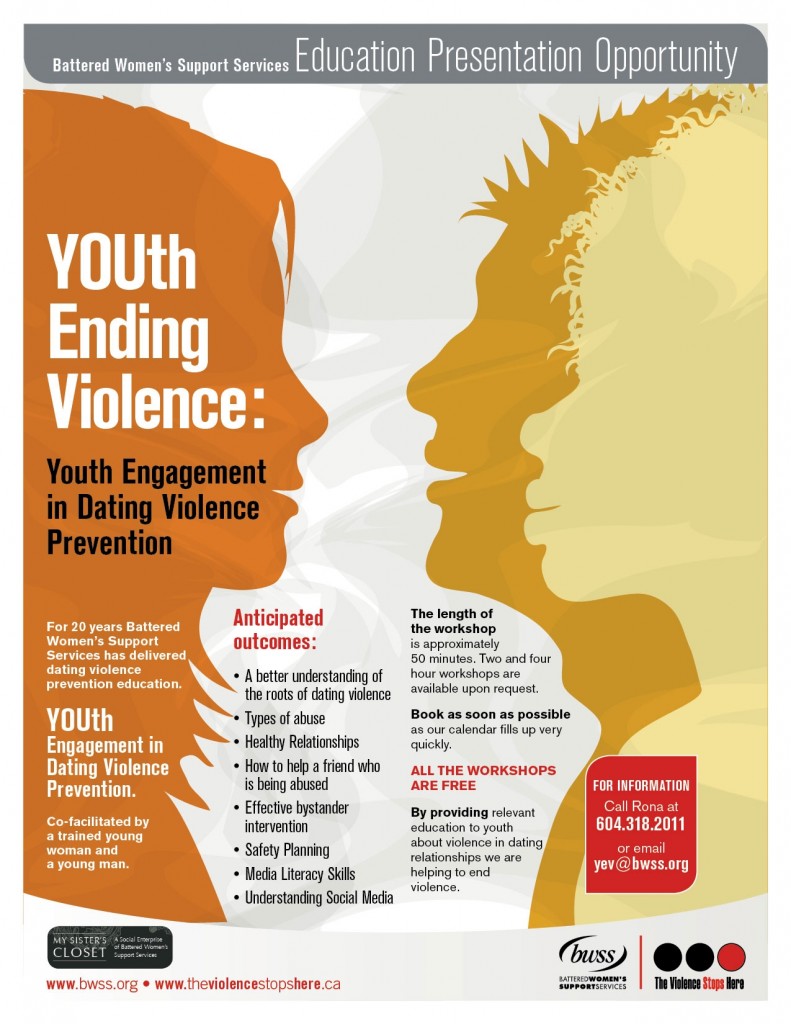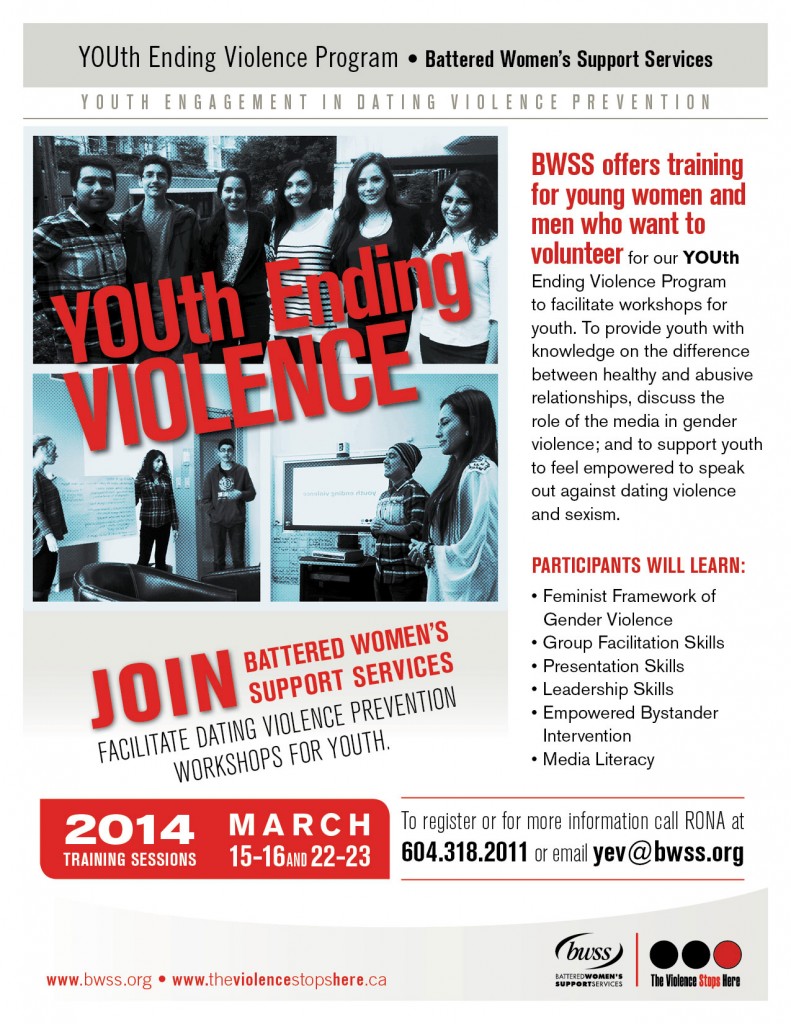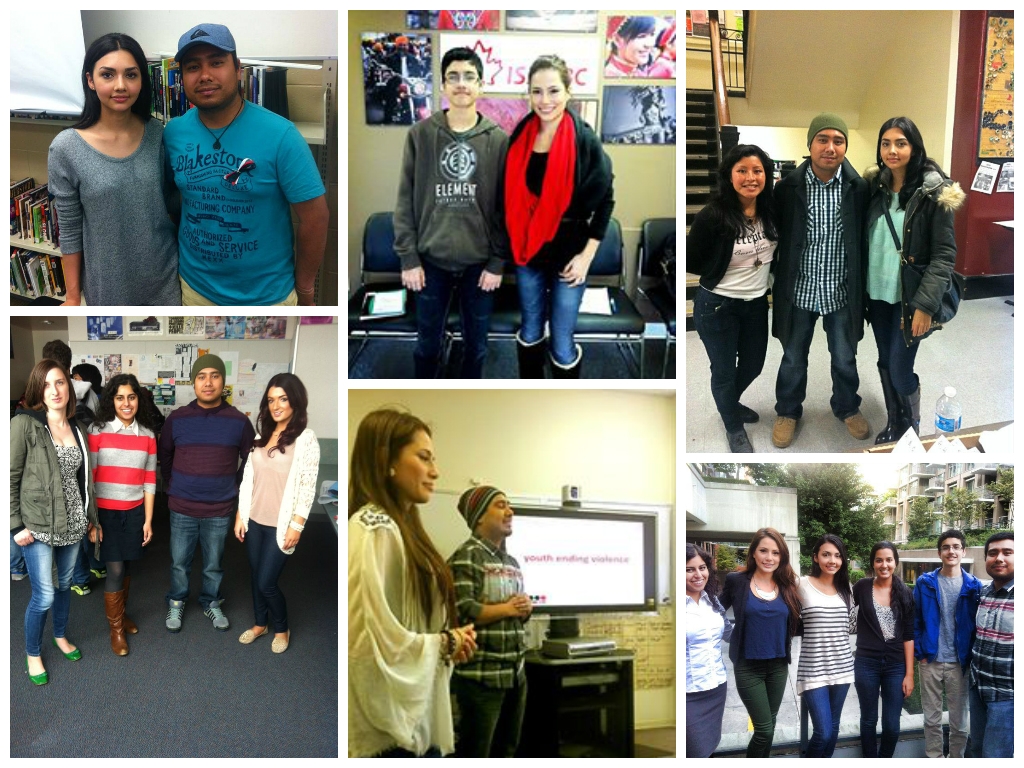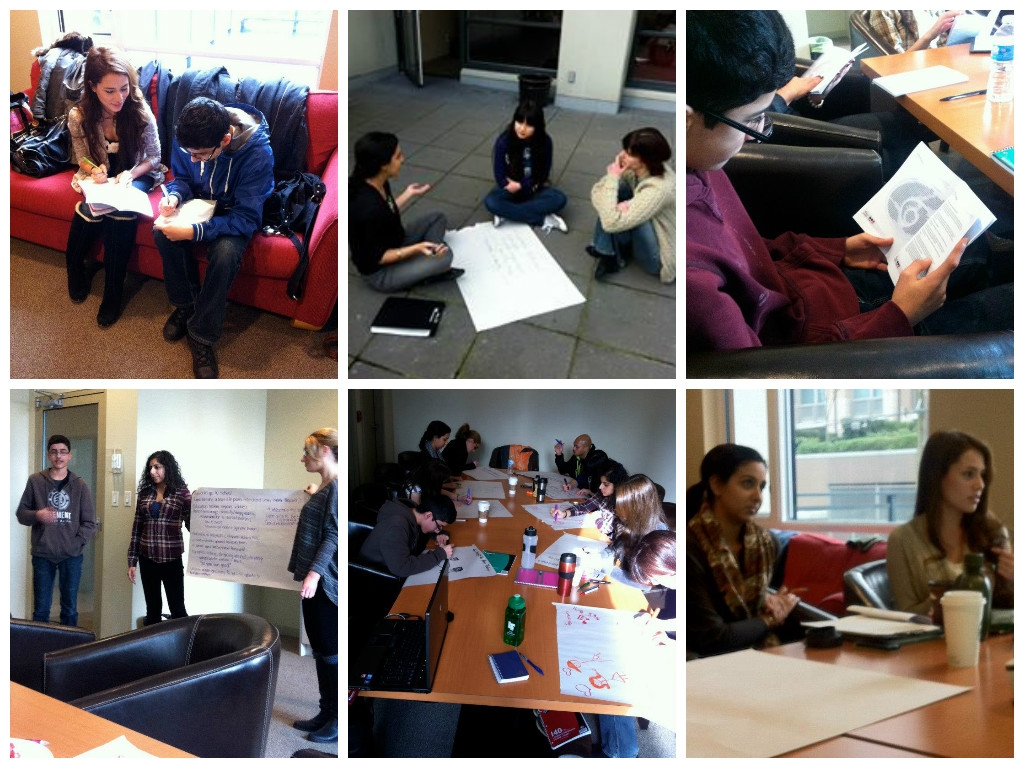Apr 18, 2013 | Battered Women's Support Services, YOUth Ending Violence

1. Use Social Media-Social media has an empowering effect send articles, with the click of a button, you can spread the word. Youth do not need the mainstream media to voice their views!
2. Report– Report photos that exploit girls and young women when you see them on social media sites like Facebook and Instagram
3. Be media literate and critical-Be critical of what you see otherwise it become normalized and we are desensitized! The media regularly uses images of violence against women and objectifies girls and women to sell products. Women are also objectified in movies, music and magazines. If you see an ad or commercial that is sexist and degrading towards women – write or e-mail the company and don’t by their products.
4. Interrupt sexist/homophobic and transphobic language-Words are powerful, especially when spoken by people who have power over others. We live in a society where words are used to put girls and women down. Gendered name-calling is used and sends the message, that, girls and women are less than fully human. When girls and women are seen as inferior, thus, it becomes easier to treat them with less respect and ignore their rights. Changing the way you speak can change the way you think.
5. Interrupt abuse –If you see a guy push a girl into her locker at school that you say something to stop him from continuing to be abusive. If you are at a party and one of your peers or friends is intoxicated and being lead away by a guy[s] stop him from being alone with her and help her get home.
6. Stop street harassment-Don’t engage in any forms of sexual harassment, such as catcalling, and unwanted touching. And don’t let your friends and peers engage in those behaviors either! It’s not just enough that you don’t engage in those behaviors, be empowered to speak up against friends and peers who do! Don’t look the other way!
7. Come up with an action plan– Plan ahead what you would do in situations where either, people you know or strangers, are being abusive and/or sexist. Sometimes it’s easier to interrupt and stop the abuse when you know what you will say and how you will approach the situation before hand.
8. Recognize the role of gender in violence- While boys and men do experience abuse it is important to remember that the majority of victims of abuse are female and the majority of perpetrators of violence are boys and men.
9. Stop Victim Blaming– Don’t blame girls and women for how they choose to dress or judge their behavior. Violence can’t be prevented through limiting the freedoms of girls. This only allows the violence to continue because perpetrators become invisible, and those who witness remain silent.
10. Stop rape culture– One way to stop rape culture is by not allowing people to perpetuate rape culture through minimizing/normalizing rape through jokes. When a friend or peer tells a joke about being violent against girls and women in some way, say you don’t find it funny and let them know that it is not okay.
11. Call gender violence what it is-not bullying-Using the term bullying to label violence against girls and women masks the truth of what’s happening. When someone you know at schools is experiencing gender violence either in a dating relationship or from their peers at school, by labeling it correctly you are stopping a culture, which normalizes and minimizes violence against girls and women.
12. Educate yourself on the roots of violence-Violence against girls and women stems in male dominance and the socialization of men. Become educated on the roots of violence against girls and women! Read books and articles, join a group at school and attend any training available to you. Learn about the myths and realities of gender violence and understand how our society condones it.
13. Create safe spaces to discuss gender violence– Create an after school club or group where you can openly discuss your views and experiences and support your peers.
14. Confront yourself/your ideas-Reflect on your beliefs and why you have those beliefs and your actions, and opinions. Be honest and admit your faults and commit to changing the way you think and act.
15. Stop stereotyping men’s and women’s roles-Social roles and expectations may affect a man’s decisions about relationships. Men are taught that expressing feelings is not masculine. Examining your social role and learning ways to express feelings directly and non-violently can help to create deeper and more meaningful interpersonal relationships. You don’t have to prove yourself.
16. Remember violence is a choice- Don’t make excuses for friends and peers who are violent. Stop supporting the notion that violence is due to mental illness, lack of anger management skills, alcohol and drug use, stress, etc.
17. Be Supportive-When girls tell you about violence they have experienced in their lives believe them. It is extremely rare for girls to make up a story about rape or abuse. You may be the first and only person she tells. Believe her and support her decisions, without being judgmental.
18. Be aware of resources for girls and women-Support girls and women by providing information on where they can get further support and safety. Familiarize yourself with the resources for girls and women in your community, including women’s centers, counseling centers and health service organizations. Be a positive resource for girls close to you by sharing information and making referrals.
19. Talk to others about ending violence and be a mentor– Volunteer your time to preventing violence by speaking to others. This brings awareness to the issue, which will motivate others to act.
20. Understand consent- Boys and young men need to be respectful when entering into a sexual relationship and should not feel entitled to girls and women’s bodies. Just because you are a ‘nice guy’ does not mean you should have any expectations.
Remember gender violence is not an individual issue- We all have a role in ending violence against girls and women and it is important that we all take responsibility in ending the violence.
During Prevention of Violence Against Women Week we will engage our online community in violence prevention by remembering we all have a role to play in preventing violence against girls and women as individuals, in our relationships, in our community and in society.
For more information about “It’s in Your Hands”, please visit:
Preventing Violence Against Women – It’s In Your hands
Gender Violence in the Workplace
Mar 25, 2013 | Battered Women's Support Services, YOUth Ending Violence
Much has been said and written about the two young men, Trent Mays, 17 and Ma’lik Richmond, 16, who sexually assaulted a young woman in Steubenville, Ohio. The majority of sexual assault cases do not receive attention in the way that the Steubenville case has in the media. There are many lessons to learn from this highly publicized case including the role of bystanders, social media, sports culture, convictions and the response from mainstream media.
Role of Bystanders
Bystanders had a large role in this case, as they do in many cases of sexual assault. One of the bystanders, Evan Westlake, was the designated driver night; he realized his friends were too drunk to drive so he tricked them into handing over their car keys. However, Westlake did not intervene in the same way when he saw his friends sexually assaulting the young woman who was unconscious. Westlake had the opportunity to prevent his friends from sexually assaulting Jane Doe by firstly interrupting and stopping the sexual assault that was happening in the backseat of his car and secondly refusing to let the young men take her to another house.
Westlake said about the rape: “It wasn’t violent, I always pictured it as forcing yourself on someone.” For this reason, discussion about Westlake’s lack of intervention has been around the need for education around consent. And while discussions and education about consent are incredibly important and valuable there has been little to no discussion about the role of male sexual entitlement in all of this.
Male Sexual Entitlement and Consent
There is a culture of sexual entitlement for boys and men, which is the belief that “men are owed sex on account of their maleness”. This revolves around the notion that girls and women’s bodies are objects, which exist for male pleasure.
In this case for Westlake it was not a question of whether or not the boys had consent. It is highly probable Westlake and the perpetrators understand consent. Westlake probably didn’t say anything because he like others believed the young men were entitled to Jane Doe’s body due to male entitlement. Differing from how it is currently being presented as Westlake not understanding consent. They knew what happened that night was rape because they discussed what they had done in a video where they repeatedly called what they had done that night rape. Furthermore, in messages on social media the young men said “the dead girl” was “so raped.” Which illustrates they knew what they had done was rape. It appears that it is not about not understanding the meaning of consent, but rather, not caring about having consent or not.
Role of Social Media
Social media is involved in many cases of gender violence especially for youth who use social media as a means of communicating with one another on a daily basis. Not only were there witnesses to the sexual assault but also other youth were aware of what happened through text messages and twitter postings. Social media has become a new medium for gender violence. The young woman’s humiliation quickly went viral. In this case, much has been said about how social media helped solve this crime. Texts messages, you tube videos, photographs on Instagram and posts on Twitter and Facebook were all used by the police to document what happened that night in Steubenville.
In this case, much has been said about how social media helped solve this crime. The judge advised those who witnessed the assault “to have discussions about how you talk to your friends, how you record things on the social media.” The reaction to the use of social media in cases like these should not be about not recording or taking photos of crimes, instead it should be how to use social media to prevent and stop violence against girls and women as it is happening.
Sports Culture & Masculinity
The sport of football is a hyper-masculine and physically aggressive sport that contributes to maintaining stereotypical notions of what it means to be a man (ie, tough, strong, physical, a leader). Football in Steubenville is highly regarded and the town’s sense of pride is connected to their high school football team and its players, which most likely attributed to the young men having power within the community.
Where were the male adult role models for these young men in all of this? A large part of the issue is the lack of positive male role models for boys and young men. One of the perpetrators biological father addressed the court and the victim’s family, placing some of the blame for his son’s actions on himself for being an absentee father.
However, it seems that regardless of the young man’s father not being around the boys had many adult male role models in the form of coaches on their football team. There is evidence that the football coach, Reno Saccoccia, was aware they raped the young woman and even tried to protect them from persecution. Text messages indicate the coach led the young men to believe the rape wasn’t a big deal at first: “Like, he was joking about it, so I’m not worried.” There is also evidence that one of the perpetrators sent his coach a text message saying he ‘took care of ’ the rape allegations. Thus, it is clear their coach was aware of what was going on and by trying to help them from getting in trouble he only validated their idea that they did not do anything wrong.
Victim Blaming, Apologists & Media Response
As with most cases of sexual assault this young woman experienced a great deal of victim blaming. People are quick to judge and analyze decisions and so called ‘mistakes’ of young women who are sexually assaulted, instead of the actions of the perpetrators. In this case the young woman has been criticized for drinking too much, for agreeing to hang out with the boys and for “ruining” the lives of her rapists.
There has been little to discussion around this young woman thinking she may have been drugged while out that night. Almost immediately after arriving at the party that night a “date rape” drug was put into her drink because she has no memories of what happened that night after being picked up. The young women thought she was aware of everything she drank that night, and had never blacked out before.
There are a lot of judgments of Jane Done and her decisions. Girls and women are expected to constantly be on guard to protect themselves from attackers however there is little to no discussion telling boys and men not to drug women and rape women. This steams from the large emphasis that is put on the actions of girls and women as if our choices make us guilty for being sexually assaulted. The conversation needs to move away from why wasn’t she more careful with her drinking and instead look at why young men are drugging and sexually assaulting young women at parties. The response from the public and the mainstream media reveals to us a culture where the person who is raped is the guilty one for allowing it to happen instead of the individual[s] who commit the crime.
Following the guilty verdict the young woman in Steubenville experience an onslaught of death threats through social media. Two teenage girls have been arrested for allegedly threatening the young woman following the verdict. Not only did this young woman experience gender violence by the young men who assaulted her, she was further harassed and threatened by her peers who blamed her for ruining the lives of the young men who raped her.
She knew the young men who betrayed her trust and sexually assaulted her. She went to the party that night because she liked and trusted those young men. There are many cases, just like this one, where young women are sexually assaulted and raped by boys and men they know. Those young men told her that they were taking care of her while she was drunk. Yet, the public believes rape, is perpetrated by criminals in the ‘shadows’ who are strangers.
The young woman was blamed for ruining the lives of the perpetrators and the mainstream media’s response to the conviction was atrocious. For example, following the verdict a reporter from CNN talked about the young men as if they were somehow victims in all this: “these two young men that had such promising futures, star football players, very good students, literally watched as, as they believed their life fell apart”. The media reports (especially from CNN) were so ridiculous they were, unfortunately, almost comical and very similar to this Onion News parody from 2011.
Conviction
The young men received the minimum sentence for their convicted crimes, with the possibility of remaining in juvenile detention until age 21. The judge set the minimum sentence of one year for Richmond and Mays was sentenced to an additional year for distributing nude images of a minor. Mays and Richmond will be added to the juvenile sexual-offenders registry as well.
It’s important to note that the Steubenville conviction was an exception and not the norm. Even a friend of the young male offenders said the boys would not be convicted if the case would be taken to court. This is because many boys and men know that there are very few, if any consequences when it comes to violence against girls and women. It is highly probable that without all of the media attention on this case there would not have been a conviction.
Sexual assault and rape in many instances are underreported and in the few cases where they are reported very few result in convictions. Specifically, in Canada we know only 9% of sexual assaults are reported, only 33% of those result in charges, and only 11% of those result in convictions. (http://www.statcan.gc.ca/pub/85f0033m/85f0033m2008019-eng.pdf)
Although this specific case has now ended, it is important to continue the dialogue around consent, male sexual entitlement and the role of social media in gender violence. We invite you to join our conversations on how we can be effective bystanders, when it comes to youth and gender violence, on our Face Book and Twitter pages.
 Rona Amiri is the Youth Ending Violence consultant at Battered Women’s Support Services.
Rona Amiri is the Youth Ending Violence consultant at Battered Women’s Support Services.
She co-facilitates workshops for youth in the Greater Vancouver area. She is passionate about working with other youth and supporting them in their empowerment process. Her mission is to see a change in youth culture where young women and men feel empowered to interrupt sexist and abusive behaviors and help end gender violence.
![]()
![]()


 You can download the poster
You can download the poster 








